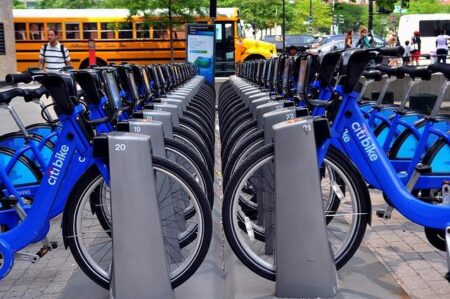As discussions surrounding infrastructure funding heat up in the United States, cyclists are bracing for potential cuts that could significantly impact the safety and accessibility of bike paths across the nation. With multiple states signaling reductions in budget allocations for cycling infrastructure, advocates are sounding the alarm, urging riders and supporters to take decisive action. Officials have asserted that “we’re not going to be spending money on bike paths,” raising concerns over the future of sustainable transportation as cities grapple with the need for improved mobility solutions. As urban centers seek to address congestion and environmental concerns, the looming cuts pose a serious threat to progress made in promoting cycling as a viable alternative to car travel. In this article, we explore the implications of these funding cuts, the current state of cycling infrastructure, and what stakeholders can do to advocate for a bicycle-friendly future.
Urgent Call to Action for Cyclists as Infrastructure Funding Faces Cuts
The alarming proposal to cut infrastructure funding has sparked outrage among cycling advocates nationwide. With the potential for reduced investment in bike paths and safe riding conditions, the cycling community is urged to mobilize and make their voices heard. Cyclists are encouraged to engage in grassroots activism by reaching out to local officials, attending town hall meetings, and rallying fellow cyclists to highlight the importance of safe, accessible routes. Every call, email, and social media post counts in amplifying the needs of those who rely on cycling for transportation, recreation, and exercise.
Furthermore, immediate action can take various forms, including:
- Sign Petitions: Join online movements advocating for cyclist rights and infrastructure funding.
- Organize Rides: Plan community rides to demonstrate the number of cyclists in your area.
- Engage with the Media: Write letters to the editor or op-eds to inform the public about the benefits of cycling infrastructure.
To illustrate the positive impact of cycling infrastructure, consider that communities with robust bike paths see significant improvements in:
| Benefit | Impact |
|---|---|
| Reduced Traffic Congestion | Enhanced mobility for all users |
| Health Improvements | Decrease in obesity rates and related health issues |
| Environmental Benefits | Lower carbon emissions from reduced vehicle use |
By demonstrating the wide-ranging advantages that come with investing in cycling infrastructure, advocates can convince policymakers to reconsider these cuts. Now is the time to act before crucial funding disappears, putting countless cyclists at risk.
Impact of Budget Reductions on Cycling Safety and Accessibility
As budget reductions threaten to undermine essential cycling infrastructure, the implications for safety and accessibility are profound. The lack of investment in bike paths and dedicated cycling lanes can lead to increased conflicts between cyclists and motor vehicles, heightening the risks faced by those who choose to ride. Without secure cycling routes, many potential cyclists may opt for less active modes of transportation, further exacerbating traffic congestion and undermining public health initiatives aimed at promoting active lifestyles. The disruption of funding not only hampers the development of safer pathways but also sends a message that cycling is not a priority for urban planning.
The effects of these funding cuts extend beyond immediate safety concerns; they also undermine broader efforts to create inclusive and accessible cycling environments. Communities that lack adequate cycling infrastructure experience:
- Reduced mobility for underserved populations
- Limited economic opportunities associated with increased cycling traffic
- Negative impacts on the environment as fewer people cycle
In light of these developments, community advocates are encouraged to take action, utilizing social media platforms and local meetings to emphasize the need for sustained investment in cycling infrastructure. Mobilizing public support can help demonstrate to policymakers that a commitment to cycling safety and accessibility is essential for thriving, sustainable urban communities.
Strategies for Advocates to Mobilize Support for Sustainable Transportation
As the threat of funding cuts to essential infrastructure looms, advocates for sustainable transportation must adopt innovative strategies to rally public support and influence decision-makers. Community engagement is crucial; local initiatives such as organized rides, workshops, and awareness campaigns can galvanize residents to express their needs and desires for safe, accessible bike paths. This grassroots mobilization can be enhanced through social media platforms, where advocates can share compelling stories, statistics, and visuals that demonstrate the benefits of sustainable transportation-both for individual well-being and environmental health.
Moreover, forming coalitions with diverse stakeholders can amplify the push for infrastructure funding. By partnering with health organizations, local businesses, and environmental groups, advocates can present a united front that underscores the multifaceted advantages of cycling infrastructure. Meetings with local government officials, accompanied by easily digestible data on economic benefits and health improvements, can further solidify the case for investment. The following table summarizes effective strategies for outreach and coalition building:
| Strategy | Description | Potential Partners |
|---|---|---|
| Community Rides | Organize bike rides to showcase routes and safety | Local bike shops, schools |
| Social Media Campaigns | Utilize visuals and stories to raise awareness | Local influencers, environmental groups |
| Public Meetings | Engage community through discussions and feedback | Neighborhood associations, civic groups |
| Partnership with Health Advocates | Highlight health impacts of cycling | Hospitals, fitness organizations |
Insights and Conclusions
As cyclist advocates brace for potential budget cuts that could cripple infrastructure development, the call to action is clear: the future of cycling in the United States depends on community engagement and political advocacy. With voices from grassroots organizations and seasoned cyclists alike urging citizens to speak up, the message is that now is not the time to be complacent. As cities expand and environmental concerns mount, investing in safe, accessible bike paths is essential for fostering sustainable transportation and promoting public health. The coming months will be crucial in determining the fate of cycling infrastructure in America, underscoring the need for a united front. Only through collective action can cyclists and supporters ensure that the paths ahead remain open and safe for all.











